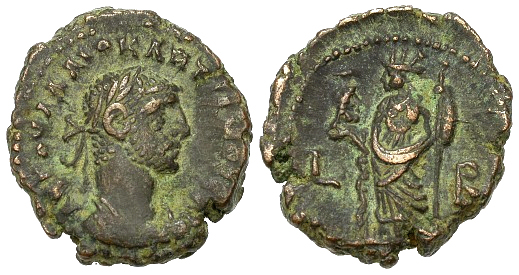

BASTET & SERAPIS Diocletian, 20 Nov. 284 - 1 March 305 A.D., Roman Provincial Egypt
Billon tetradrachm, Milne 4781, Curtis 1954, Geissen 3210, BMC Alexandria 2529, SNG Cop 980, VF, Alexandria, 6.663g, 21.5mm, 0o, 29 Aug 285 - 28 Aug 286 A.D.; obverse "A K G OUAL DIOKLHTIANO"C C"EB", laureate, draped and cuirassed bust right; reverse Alexandria standing left, wears turreted cap, head of Serapis in right, scepter in left, L - B (year 2) across fields.
The ancients did not all agree on the attributes of Serapis. A passage in Tacitus affirms that many recognized in this god, Aesculapius, imputing healing to his intervention; some thought him identical with Osiris, the oldest deity of the Egyptians; others regarded him as Jupiter, possessing universal power; but by most he was believed to be the same as Pluto, the "gloomy" Dis Pater of the infernal regions. The general impression of the ancients seems to have been that by Serapis, was to be understood the beginning and foundation of things. Julian II consulted the oracle of Apollo for the purpose of learning whether Pluto and Serapis were different gods; and he received for an answer that Jupiter-Serapis and Pluto were one and the same divinity.
An altogether gorgeous coin, with plenty of psychometric punch and a peculiar connection to the Temple of Bastet, recently discovered in the City of Alexandria; it was constructed as a temple for Queen Berenike, the wife of King Ptolemy III who ruled Egypt between 246 and 222 BC.
A cachette of 600 Ptolemaic statues and a number of coins of the Diocletian period were also unearthed during the routine excavations, including a large collection of icons depicting Bastet, goddess of protection and motherhood.
The Ptolemaic period marks the Greek rule of Egypt from 305 BC until the Roman conquest in 30 BC. Alexandria became the capital city of Ptolemaic Egypt and thrived as the centre of Greek culture and trade.
$375.00
40387p00